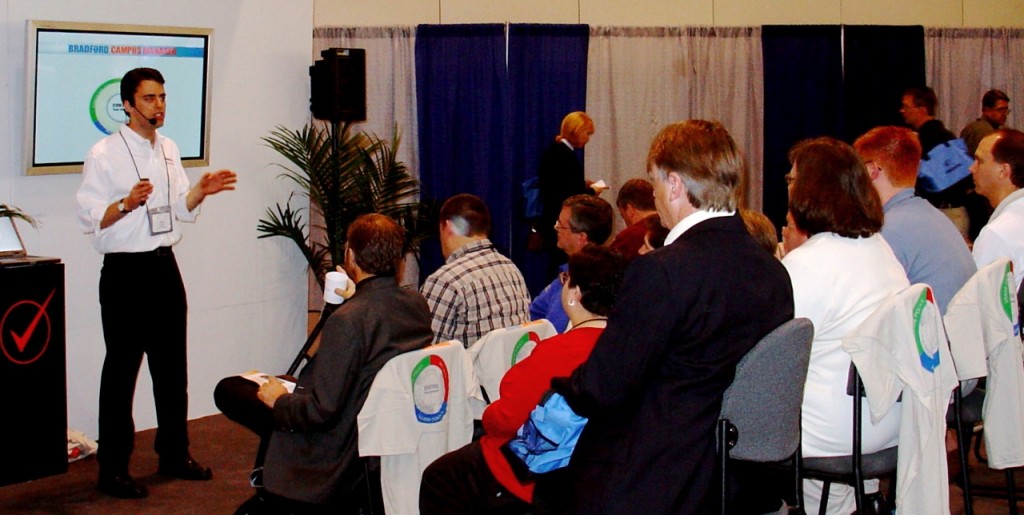November 19, 2012
by Andy Saks
Are you a fan of recycling, finding ways to get the greatest possible value from something by reusing it for different purposes?
Here at Spark we’ve applied that concept to trade show presentations with a setup called the “skeleton script.” Spark client Bradford Networks took advantage of it, and we saved them thousands of dollars and dozens of hours in the process.
Bradford is a computer networking security company based in Bradford, New Hampshire. A few years ago, Bradford’s marketing team looked at its upcoming trade show exhibitor schedule and noticed it featured three “vertical-market” shows: HIMSS (health insurance), RSA Conference (computer security) and Educause (tech in higher education).

Professional trade show presenter Andy Saks speaks for Bradford Networks at the Educause Conference in Orlando
Bradford had already booked Spark owner and professional trade show presenter Andy Saks to write and deliver its booth presentations at all three trade shows. Would pitching different products different ways to different audiences with different needs at three different shows mean paying Andy to write three completely different trade show presentations?
Thankfully, no. At Spark, we like finding the most cost-effective angles for our clients. Andy didn’t want Bradford to waste its valuable resources, so he suggested the “skeleton script” approach.
The idea is simple: write the “bones” of a generic script that could be used for any show, then adapt it for each show with specific “flesh” details for that show’s audience.
Here’s how it played out:
First, in consultation with Bradford, Andy wrote a bare-bones trade show presentation script that could be used at any trade show, with a generic greeting, company description, Core Claim, product description, outro and announcements. These elements usually comprise about 70% of the total script.
Next, a week or so before each trade show, Andy tailored the script with a handful of key details tailored to that specific industry: audience pain points, product features and benefits, client lists and success stories. These customized elements comprised about 30% of the total script, and made it feel unique to each industry and audience.
This script revision process took about two hours of editing per script, versus the 10-15 hours needed to write a new script from scratch. When you’re paying by the hour, that’s great news.
Finally, Andy tailored a handful of related slides in the presentation deck to match, changing specific words, client logos, and other details.
This slide revision process took about 1-2 hours, instead of the 10-20 hours needed to build a slide deck from scratch.
At the end of its three-trade-show run, Bradford owned three vertical-market product presentation scripts. Each one looked 70% the same to us, yet each industry audience thought Bradford had designed it just for them.
But wait; could Bradford get even more use out of these scripts?
Sure they could.
Bradford’s own marketing team did a bit more nipping and tucking on the skeleton script and created a fourth script for the financial market, then a shorter fifth script for an internal presentation. Then they booked time at a local TV production studio and booked Andy to deliver all five scripts as on camera talent.
In just half a day, with the help of his Earprompter, Andy delivered all five presentation scripts on camera. Bradford then produced a video of each presentation.
Suddenly, Bradford found itself the owner of five compelling product introduction videos suited for all vertical markets in which they competed.
Bradford uploaded each video to its corporate website and social media sites, where they were seen by visitors from around the world, ensuring those trade show scripts would pay off for years after the trade shows ended.
Bradford also burned DVDs containing all five videos and distributed them to Bradford’s outside sales team, who showed them at the beginning of each sales pitch to get prospects up to speed quickly.
Here’s the video Bradford produced for the financial markets based on Andy’s trade show skeleton script, and featuring Andy on camera:
In all, Bradford used its single “skeleton” script to spread their message on its website, at three trade shows and in numerous prospect pitches, saving them thousands of dollars and dozens of hours creating new scripts from scratch.
Now that’s good recycling!
You can see more video clips featuring Andy in the More On Camera Video Clips page, and on Spark’s YouTube channel.
RELATED “TRADE SHOW BOOTH IDEAS” POSTS
Why use a professional trade show presenter?
How do I hire the right trade show presenter?
How do I get more value from my presenter?
How do I increase my trade show presentation audience?
Script Tips: 10 ways to make your presentation script sparkle
Tips for first-time trade show exhibitors
How do I create a traffic jam at my booth?
Did you pack your trade show toolkit?
ABOUT SPARK PRESENTATIONS
Spark Presentations is a private company founded in 1998 that provides presentation skills training and speech coaching for executives, salespeople, marketers and other businesspeople, plus booth staff training for trade show exhibitors.
Spark also books professional presenters and public speakers to represent its clients at high-profile events, in roles like keynote speaker, trade show booth presenter, master of ceremonies (emcee) and auctioneer, as well as on camera talent and voice talent.
Spark’s client list includes large corporations like AT&T, Best Buy, FedEx, Hyundai, Intel, Kimberly-Clark, Olympus, Owens-Corning, Panasonic, Samsung, Sony, and Volvo; high-tech industry players like AMD, Atrion, Citrix, Gigamon, and Symantec; service organizations like Vistage, 1nService and NERCOMP; and New England institutions like the Boston Jewish Film Festival.
Spark’s owner, Andy Saks, is also the author of The Presentation Playbook Series, a three-volume set of books that help businesspeople master common presentation situations by building and running speaking “plays” like a coach or player calls a key play in a game.
Add your comment